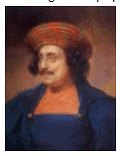Chapter Test: Women, Caste and reform - CTET & State TET MCQ
10 Questions MCQ Test Social Studies & Pedagogy Paper 2 for CTET & TET Exams - Chapter Test: Women, Caste and reform
An image of a popular reformer who founded a reform association Brahmo Samaj is given below. Name this personality.

| 1 Crore+ students have signed up on EduRev. Have you? Download the App |
Painted by a European artist who came to India, this was one of the many pictures of a religious practice, a social evil that existed in ancient India. Identify the name of the practice

Among the following, which class belonged to the traders and money lenders
With respect to ancient India, a list of statements related to the untouchables are given below. Point out the one that is not TRUE.
Under which Governor General did Raja Ram Mohan Roy initiative to ban Sati?
Name the class that belonged to the lower most strata in the social ladder of ancient India
Who has been referred as the Prophet of Indian Nationalism?
Name the uppermost caste in the social ladder that existed in ancient India
Few important points with respect to Raja Ram Mohan Roy are given below. Select the one that is NOT TRUE.
|
61 videos|119 docs|77 tests
|
|
61 videos|119 docs|77 tests
|

















